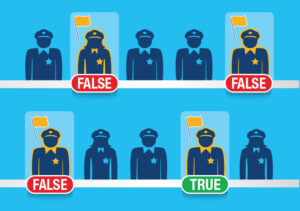The following is part 2 of 2 in our IACP Leadership Series conversation between Benchmark CEO Ron Huberman and Thomas Eicher, Executive Director of the Office of Public Integrity and Accountability, New Jersey Office of the Attorney General. In this entry, Mr. Eicher discusses new polices his state is implementing to improve transparency and accountability, moving toward a more effective, evidence-based early intervention system — as well as sharing his thoughts on various policing reforms over time and the need to look at the criminal justice system as a whole.
RH: Tom, let’s continue our discussion on police reform policies being initiated or expanded upon in your state of New Jersey. Your novel concept of tracking and reviewing use-of-force incidents statewide by assigning a county prosecutor to work with every agency is breakthrough. What else are you implementing?
TE: Sure. The other thing we looked at was transparency, and we issued an updated body-worn camera policy that requires disclosure to the public within the completion of the initial investigation, typically 20 days for a police-involved shooting. We have expanded that to not only body-worn cameras, but dash cams and private cameras that might inform the public what really happened during a particular incident.
We issued an amended policy about impeachment material for officers. Even though it’s been the law for a long time, we had not had a statewide policy that really set out in any detail the requirements to track and make available to defense counsel and defendants impeachment material about the officers who were testifying. We put that in place. We, again, pushed that on the county prosecutors a bit to put them at the frontline to gather that information and
make it available.
We thought these two updates were important reforms to strengthen public trust and heighten transparency. We also continued and emphasized our resiliency program where we looked at trying to help officers who needed assistance because of a problem in their life – such as a drug or alcohol issue –making it easier for them to reach out and get help without incurring disciplinary action.
Finally, and this is a work in progress, we are looking at how we can improve the early warning system directive that we have, and move it more towards an early intervention system — improving the capacity, either on a statewide level or within the individual departments, and the ability to implement this updated system in a way that really facilitates training, as opposed to discipline; or interventions early rather than later so that you don’t have to wait until something really goes off the rails. And importantly, using data rather than hunches about what actually is effective — as well as what you should be measuring and looking at.
That’s true for all we’re talking about . . . I think that the focus on using the data that’s available is really key. It’s what makes this multi-dimensional reform effort somewhat different than some of the earlier reforms that didn’t have that ability to gather and analyze the data — and help use that data to inform policies.
RH: You know what’s interesting, Tom? It’s that is precisely what I’ve advocated for in terms of what I’ve seen. In the ’50s we had the professional model policing: 911 came to take everything over, and everyone’s in uniform and random patrol — and it’s really what is even today the bedrock of policing. Through the ’70s, we started to see problem-oriented policing, which was followed by community policing. Community policing was concurrently overlaid with predictive policing, joined by Compstat policing in the ‘90s, leading us up to this point in time.
What’s different to me at this point in time – and that you’ve articulated as well – is the fact that for the first time in the history of law enforcement, we have data and research to actually say, “We no longer have to rely on the hunch and the goodwill of a street supervisor. We can systematize an understanding of a pattern and practice of problematic behavior in the early stages — before we have horrific incidents that really crush our profession every time they happen.”
Tom, let me just tap into your experience. You were a federal prosecutor for 30 years, with much work in civil rights crimes. Has there been a trend you can identify? Were there things that you were much more likely to prosecute 30 years ago and 20 years ago than today? And more to the point, if you will, what is the nature of problematic conduct in civil rights violations today versus 30 years ago — or is it really the same show?
TE: I think it’s pretty similar, honestly. But there has been a trend. The original cases I was involved with were more corruption cases. Police cases where drugs were stolen, money was stolen, drugs were planted, officers were on the take. Now, that was in Philadelphia; not to give them a bad name, but I was a prosecutor in the city at the time. We also saw that in New Jersey when I moved over here.
And then, whether it was because of focus or difference in conduct, the use of force over the last five to 10 years has become much more of a focal point. I think the public’s understanding of what is reasonable force for police to use has evolved. I think there was an era when the public’s attitude was, “Hey, if they committed a crime, they brought it on themselves and the police should do whatever they need to do to take care of this person.” They really didn’t care what happened to him. I think that’s changed.
I think even people who have committed crimes are being seen more as a person. And even though they deserve whatever punishment the system will result in. It shouldn’t be at the hands of the officers. I think the public’s definition of reasonable force, which is always at the bedrock of even the constitutional law, has changed. I think it’s evolved. I think the public is expecting and asking for more restraint when it can be safely done.
I think that’s a change. I think that’s different. One of the challenges in prosecuting civil rights cases – especially those for people incarcerated and I did a number of those – is that a lot of jurors at that point were like, “Hey, they must’ve done something or they wouldn’t have been in jail in the first place. And so therefore, they don’t have any rights.”
Of course, that’s not the law, but that’s a very difficult climate to bring those cases into. I think the public sentiment has changed, in part maybe, because so many people know someone who’s been incarcerated or know somebody else who knows somebody. It’s not the stigma it used to be. I think there is a more humanizing of people, and an expectation that police will deal with effectively, but fairly, with everyone they interact with.
RH: No, it’s interesting. What do you think has brought the public around? Do you have a sense of why there’s been such a shift in how it’s perceived?
TE: I think it’s an accumulation of the incidents that we’ve seen. And I think it’s the starkness of the George Floyd situation. It’s also a recognition that there is a general perception – and we can argue about whether it’s true or not – but there’s a general public consensus, I would say for the most part, that law enforcement does not always act equally with every citizen. That there is different enforcement based on race — or based on assumptions about people.
I think that the public, for the most part, is sympathetic to that. I believe that’s a big change. And I think it goes beyond the community that’s being most directly affected — and has now broadened to others who were not part of that community, but feel that changes have to be made to make sure it’s not happening. So, I think that’s a big difference. I also believe that police are open — they want to do a good job. My experience has been that police don’t want to be the bad guys.
There are some bad apples, of course, but most police want to do a job effectively, want to do it fairly, and want to see themselves in that light . . .and I think they should. We have to give police the tools, the policies, and the training to do it. I think we didn’t do that.
To just anticipate a little bit of your question or what you mentioned about community policing, I think the Compstat model overran community policing. By focusing on data to see where crime hotspots were, and then deploying resources in that way, what it did is it tended to be almost a self-fulfilling prophecy. Less affluent neighborhoods, which in the major cities tended to be more minority, got much more attention from the police. So, then there were more arrests . . . and those arrests lead to more arrests. I think while it suppressed crime, it also created a really negative interaction with the community that I think has to be undone — through the community policing aspects of where you’re interacting, not just in a bad context, but in a normal everyday context.
The data that led the Compstat reform was effective in a way, but it undermined that community relationship in a way as well. I’ll give you an example: I won’t say the name of the case, but it involved the investigation of a fatal police encounter. The citizens that I spoke with about it said, “the police are always here harassing us. They’re in our neighborhood and they’re just always trying to catch us on some little things so they can stop us, try to search us, and see if they can find something.” I said, “All right. I understand that perspective.”
I talked to the police officer and I said, “What were you doing?” “We were on directed patrol”, he replied. “What does that mean?”, I asked. “We were in a neighborhood, a high crime neighborhood trying to catch them doing something like running a stop sign, so we could stop them and try to catch them with something”, he responded. They were both talking about exactly the same thing. The police thought it was highly effective law enforcement, and the neighborhood thought it was a means of oppression and being picked on.
It was interesting to see that the very same description of it almost leading to very different conclusions. I think both of them have some merit, but I believe if you’re only focusing in on one, and not the other, you’re going to lose the big picture. I think that’s what happened with Compstat.
RH: What’s so interesting, in my personal experience when I was a Chicago police officer, CAPS – which was the big Chicago police community initiative in the mid-’90s – was a major focus concurrent with Chicago’s version of Compstat. These initiatives were living concurrently — or trying to live concurrently. I think both had different success outcomes and both negated each other at some level.
What worries me a little bit about the current chapter of police reform, Tom, is the defund the police movement which I’m going to argue is not about funding per se, but just people being punitive by being in support of taking money away from the police. There’s an argument to be made that we should ask the question, “Who is the best person or group to deal with what situation?” I don’t think anyone’s going to pretend a police officer’s mental health training impacts a situation the way a mental health worker’s experience does. But to the degree that we peel the police away from humanizing interactions – giving that job away to other people – and leaving the police only to deal with crimes alone, we’re going to lose a certain humanity in all of this that could cause its own issues.
Tom, I’m going to close up with just a few questions. All of us who care a lot about the profession of policing and want to see it continually professionalized and elevated, we worry about democracy. Stick with me for a minute. There’s a whole body of political science that advises, “To the degree that people have faith in the systems of justice.” It’s not just the police . . . but police, courts, due process, etc. I believe when there’s a high level of public confidence, you see very stable democracies.
When you have a low level of faith in the systems of justice, you tend to see very weak democracies. If you look at South America, where there’s unbelievably low levels of confidence in systems of justice, you see democracies turn all the time. Very unstable governments. Well in the United States, much more so recently, folks’ faith in the systems of justice is deteriorating at a rapid pace. If you believe the work – you could say that’s a proxy to the health of our society, we should all be extremely worried about these reform efforts and building the trust.
Tom, what do you think we need to do to restore faith in policing, make it the honorable profession that it should be, and in many cases is, to the average American?
TE: I think that’s a really interesting question and it’s not one that a lot of people are focusing on right now. Part of it is, we require the police to do everything. We release people from the large mental health institutions and put them on the street — and the police are the first respondents, so that’s one.
Second, police also are saddled in some ways with the overall criminal justice system. Here’s what I mean by that; maybe I shouldn’t say this, but in one of the police departments that I’m involved in looking at, what we found was that African Americans had much more higher rates of arrest than Caucasians — and that’s obviously troubling. When we dug down a little more, what we found was, a lot of that difference can be explained by bench warrants out for individuals. They’re pulled over for speeding and they have a bench warrant. Well, if they have a bench warrant, the officer is going to arrest that person. They can’t ignore that warrant; It’s there, they’ve got to enforce it. What I mean is police are doing their job, but that can result in a lot of negative feelings by the community.
What do we have to do? We have to step back as we’re policing and not just focus on policing, but look at the criminal justice system at large. Is it really appropriate to have so many bench warrants for basically economic failures? You didn’t pay a fine, you didn’t pay the restoration fee on your driver’s license, you committed a crime, and now we’re going to tack financial penalties on top of it. So, a lot of that, as we saw on Ferguson [Missouri], is underlying a lot of the discontent with the police. The police are the face of that system that’s really, at some level, arguably oppressive to the people.
Not that they didn’t incur the fine, not they didn’t double-park or over run their meter — but the cumulative effect of it is, it creates this enormous negative energy between the people and the government. I think we have to step back. There have been those efforts by the Chief Justice in New Jersey and others to look at, “Is this the right way to do it? Should we be arresting somebody for an old parking ticket from a couple of years ago? Are there better ways to resolve that?” So, I think that’s part of what we have to do, is we have to help the police by taking a look at the big picture, at the whole criminal justice system, to see if we can do it in a more efficient and better way — and a more humane way. I think we can.
We’ve seen that in some of the re-entry efforts around the country that – once somebody’s served their time – it’s in everyone’s interest to see them succeed and to knock down barriers to that success. That’s just good common sense, because if you don’t do it, you’re going to end up with another person cycling through the system. I really do think what we have to do is not limit our focus to the police, but broaden it to the criminal justice system as a whole. And that requires some really fundamental discussions about what direction we want to go.
RH: Yes, I know. I’m so glad you brought that up, because I agree. There’s a big picture piece here and the micro-focus on police ultimately will not solve this problem; it’s bigger than that. We’re grateful for your service to our country as a prosecutor within the State of New Jersey — and everything that you do to elevate policing.
This interview from October 2020 has been edited for clarity.
 The first iterations of early intervention systems were relatively primitive compared to some of the more sophisticated systems in use today. Most notably, limitations in tech – processors, and data storage capacity posed challenges to complex and resource-intensive data analysis. These early systems also lacked the benefits of decades of research and on-the-ground experience, which are critical elements of an effective EIS. Given these limitations, most of those systems (and almost all today) relied on rules-based thresholds:
The first iterations of early intervention systems were relatively primitive compared to some of the more sophisticated systems in use today. Most notably, limitations in tech – processors, and data storage capacity posed challenges to complex and resource-intensive data analysis. These early systems also lacked the benefits of decades of research and on-the-ground experience, which are critical elements of an effective EIS. Given these limitations, most of those systems (and almost all today) relied on rules-based thresholds: For municipalities with police agencies, law enforcement-related insurance coverage is typically the most significant contributor to overall municipal insurance costs. A diverse set of factors are creating the upward pressures in premiums felt around the country including increasing severity of liability claims, statutory changes to workers compensation coverage, the global pandemic, and hard reinsurance market conditions.
For municipalities with police agencies, law enforcement-related insurance coverage is typically the most significant contributor to overall municipal insurance costs. A diverse set of factors are creating the upward pressures in premiums felt around the country including increasing severity of liability claims, statutory changes to workers compensation coverage, the global pandemic, and hard reinsurance market conditions. In the United States, a significant shift in how mental health services were funded in the early 1980s led to major changes in how officers are trained to deal with mental health issues. In the simplest terms, funding at the federal level was diverted in the form of block grants to states, which
In the United States, a significant shift in how mental health services were funded in the early 1980s led to major changes in how officers are trained to deal with mental health issues. In the simplest terms, funding at the federal level was diverted in the form of block grants to states, which 
 The Association of Government Risk Pools (AGRiP)
The Association of Government Risk Pools (AGRiP)  Commercial insurance companies were the first to offer policies specifically designed to help municipalities and law enforcement agencies mitigate their exposure to the financial risk of litigation. These policies worked on the basic principles of commercial insurance: grouping and limiting risk factors. Insurance market disruptions of the late 1970s and early 1980s led some municipalities and agencies to turn to risk pools and self-insurance. Now the vast majority of agencies and municipalities use at least one of these strategies.
Commercial insurance companies were the first to offer policies specifically designed to help municipalities and law enforcement agencies mitigate their exposure to the financial risk of litigation. These policies worked on the basic principles of commercial insurance: grouping and limiting risk factors. Insurance market disruptions of the late 1970s and early 1980s led some municipalities and agencies to turn to risk pools and self-insurance. Now the vast majority of agencies and municipalities use at least one of these strategies. Further complicating matters is how municipalities pay for misconduct settlements. In general, many small to medium-sized cities carry some form of
Further complicating matters is how municipalities pay for misconduct settlements. In general, many small to medium-sized cities carry some form of 

